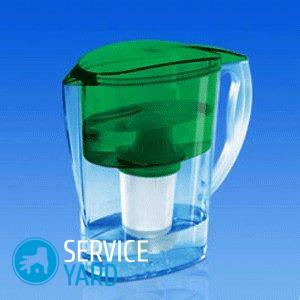
- Which filter is at home?
- What's the difference?
- How do I clean a water jar?
- How to clean a water jug from a raid?
- A few words about the store tools
- When should I clean the jug?
Before entering the water main, the water is thoroughly cleaned. Debris, organic and insoluble mineral contaminants are removed, treatment against bacteria is carried out - in a word, this is a serious and long process. Nevertheless, the quality of the liquid pouring out of the tap sometimes leaves much to be desired, which is the reason for the growing popularity of household filters. They must be kept in order. From our article you will learn how to clean the water filter "Barrier", as well as some others.
to the contents ↑Which filter is at home?
In flats and private houses, three types of filters are most commonly used:
- reverse osmosis systems;
- flowing;
- pitchers.
Reverse osmosis
The first type includes filters "Geyser".They are good if you have to purify large amounts of water - for example, for a large family. Install such a system in the kitchen or in the bathroom.
Important! It in itself is quite large, however, it does not spoil the interior at all. Outside, it is almost not visible, all large parts are removed under the sink. This is the only type of cleaning, which does not form scale on the walls of the kettle.
Its main advantage is maximum cleaning. There are, of course, also disadvantages:
- high price;
- requires professional installation;
- installation takes time;
- such a filter does not protect household appliances from scale;
- in the water there is a metallic taste.
Flow-through filters
This device is cheaper than a reverse osmosis system. It is also not necessary to boil water. The flow filter is smaller, it is easy to transport. They come in different sizes, and installation of some also takes a long time.
The most popular flowing device is Aquaphor. If we talk about the drawbacks, the main thing is that the body is made of transparent plastic, which quickly grows turbid. However, on sale it is easy enough to find an assembly of this class, installation of which will not take much time.

Jug Filters
Strictly speaking, these are also flowing, simply because of the shape of the hull they were allocated to a separate class. These are the most popular units for water purification. The device itself looks pretty simple, it has two main parts:
- pitcher;
- interchangeable cartridge.
The popularity of such devices is due to their undoubted merits:
- does not require installation;
- water can be filtered immediately after purchase;
- if the cartridge is dirty, it's easy enough to change it;
- costs such a filter much cheaper than others;
- design solutions are very diverse, so you can pick a jug under the interior of any kitchen.
An absolute leader in the market is the "Barrier" water filter. The "Aquaphor" jugs are also in great demand. The disadvantages of these models include:
- fragile cartridge case;
- water has a mild "marsh" smell;
- filter does not protect against scale;
- filter is periodically contaminated and water quality becomes worse;
- on the walls of the pitcher over time formed a raid, from which not everyone can immediately get rid of.
With a question how to clean a jug for water from a raid, so as not to disable the whole unit, one day the owners of the filters "Aquafor" and those who chose the "Barrier" collide.
to the contents ↑What is the difference?
Domestic water filters differ not only in form and mounting system, but also in what substances are used for the manufacture of cartridges:
- In "Aquaphores" a special system "Aqualin" is used. The cartridge is made of special fibers, which provide high-quality cleaning.
- In the "Barriers" the filter itself is made of ion exchange resins and activated carbon, which is a very good sorbent. In addition, in the manufacturing process, activated carbon is treated with silver, which prevents the multiplication of bacteria, even if they enter this environment.
How to clean a water pitcher Barrier?
How do I determine if the cartridge is clogged? Very simple. The filter device starts to flow the water more slowly and slowly. You can do two things:
- replace;
- clean.
Important! Buy new elements of labor is not - they are in the same store, where you bought the pitcher, as well as in large hypermarkets. They are inexpensive, and it will be much easier and quicker to change it than to clean the "Barrier" water filter.
Cleaning Tools
But there can be situations where a replacement is not possible and you have to solve the problem with the tools at hand. You will need:
- baking soda;
- table salt;
- soft brush;
- sharp knife.
Cooking solution
To fix the jug filter, you need to prepare a concentrated solution of table salt. It is better if you have at home:
- pharmacy scales;
- measuring dishes.
You can do without measuring utensils, knowing approximately the volume of jars and glasses:
- In a bowl, pour 100 ml of water.
- There, pour 5 g of salt.
- Wait for the salt to dissolve completely.
Important! The solution can be more concentrated.

Cartridge
Let's start with a cartridge first. In parallel, you can handle the pitcher:
- Disconnect the cartridge from the body.
- The jar is washed with soda - this should be done every two weeks.
- Cut off the cap from the cartridge - you will see a mesh.
- Rinse the mesh with hot water( preferably boiled).
- Put the cartridge in its place - now it is without the cap.
- Pass through it a solution of table salt.
- Rinse the system with clean water until the salty taste disappears.
Important! After the cap is cut off, the cartridge is left unprotected, so that water should be poured neatly and prevent its direct hit in the mesh.
Some tips
The "Barrier" cartridge consists of a special resin that must not dry out. That is, the water in it must always be, otherwise - the cationite will lose its properties and cease to purify water from the salts. A filter with a cut off cap can be used for a rather long time.
Important! The water that you wash the mesh should not be too hot. Enough if its temperature is 65-70 ° C.
to the contents ↑How to clean a water jug from a raid?
Despite the fact that the main element of the water jar for cleaning water is a cartridge, the hassle with it is much less than with the body. A negative white coating can not be washed away with any kind of detergents. And there are objects and substances that should be discarded immediately:
- abrasive pastes;
- rigid and melamine sponge.
Abrasive paste in such a situation is absolutely useless. On the case there will be scratches, and the raid still will not go anywhere. The same applies to hard metal wool.
With melamine sponges, everything is somewhat more interesting. In principle, they wash away the raid. But melamine itself is not useful for the body. If it gets into the stomach, it causes poisoning.
Important! To wash the pitcher filter so that there is no melamine left on it is almost impossible - there are always pores in the body, in which the tiny particles of this substance get stuck. So it's not worth the risk.
What is at hand?
Thinking about how to clean a plastic jug from a raid, look what you have at home. Even if your locker for household and kitchen accessories is completely empty, you will find everything you need in the shops and pharmacies located nearby, and at extremely low prices.
You need:
- vinegar;
- liquid ammonia;
- citric acid;
- formic acid.
Vinegar - indispensable
It is always useful to have a bottle of vinegar in stock. This is the most that neither is the ordinary substance will help out in many situations, including helping, if you think, than to clean a plastic water jug.
Option 1
To prepare the solution, you need water and 9% vinegar:
- Dilute water and vinegar in a ratio of 1: 1.
- Lower the jug nose into the solution vessel.
- Hold for 15 minutes.
- Wash the filter with running water.
Option 2
You can also use vinegar essence to prepare the solution:
- Divide the essence in water in a ratio of 1: 5.
- Put the product in a small spray.
- Spray it on the walls of the jug.
- Wait for 15-20 minutes.
- Wash the jug with clean water.
Important! Work with the essence better with gloves.

Citric acid
It helps to get out of the difficult situation, if you need to clean the jug "Aquafor" from the lime scale, and citric acid. Of course, you can use natural lemon juice, but it will be somewhat more expensive. The citric acid powder can be used both in dry form and dissolved in water.
Option 1:
- In a glass of warm water, dissolve 20 g of citric acid.
- Pour the solution into the jug so that it gets to the dirty areas.
- Wait for 15-20 minutes.
- Thoroughly rinse the jug.
Option 2
For this method, the water must be boiled and slightly cooled:
- Pour the boiled water into the jug.
- Put a bag of citric acid there too.
- Leave all this for half an hour.
- Drain the solution and rinse the jug.
Option 3
- Pour dry citric acid into the jug.
- Wet the sponge.
- Wipe the sides of the jug.
- If necessary, repeat the procedure.
Ammonium alcohol
Ammonium nitrate is a wonderful remedy, capable of much. It works wonderfully with calcium carbonate. True, it smells very strong and sharp, so it's best to use it in a ventilated room.
How to clean the water filter with this product:
- Add 10-20 drops of ammonia to warm water.
- Pour all this into the pitcher.
- Let stand ten minutes.
- Pour the solution and rinse the container thoroughly.
A few words about the store facilities
The formation of a calcareous coating on the filter walls is not only your problem. Many people face it, so the demand for detergents that can remove such a scurf is constantly growing. Manufacturers of gels and dishwashing liquids have already considered this need of their customers, so that on the shelves you can find such funds.
Important! As ingredients they use the same vinegar, citric acid or ammonia, which can be bought separately, and much cheaper. The result will be exactly the same. However, in store detergents are used, including perfumes, and this is often attracts buyers.
to the contents ↑When should I clean the jug?
How long does it take to form a calcareous coating? In different regions this happens at different rates. It all depends on how hard water gets into the water pipe or well. A clean and sparkling jug gradually loses its transparency. It is important to catch this moment in time.
The best option is to clean the vessel about once every two weeks, if the water is not particularly stiff. It's okay if you have not noticed almost any changes so far. Citric acid and vinegar to similar devices do not harm, and the procedure can take much less time than when you can not see anything through the walls.
Periodically wash the jug with acids or using other means suggested in this article and it will always shine like crystal!



